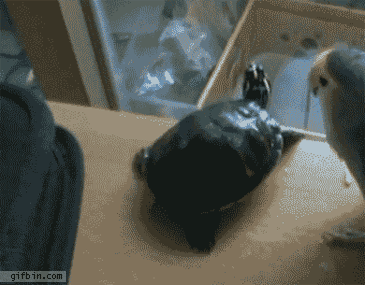
Species: Sula granti
Habitat: The Galapagos islands and eastern Pacific Ocean, wearing silly masks and killing their siblings
It ain't easy being the youngest in the family. If you're a Nazca booby, it can get you killed.
Nazca boobies are monogamous, ground-nesting seabirds. Yes, monogamy is sweet and "booby" is an amusing name, but they are far from kind to their nest mates.
During each breeding season, a female Nazca booby will lay two eggs several days apart. If both hatch, the elder sibling pushes the younger out of the nest area, where it is either picked off by predators or dies of thirst and cold.
The younger chick doesn't stand a chance: firstborn chicks can be up to 30 per cent larger, and once the young chick is outside the nest area, its parents ignore it and leave it to die sometimes just centimetres away.
Sorry, you're just the spare
This obligate siblicide is an evolutionary insurance policy taken to the limit the second egg is simply a back-up in case the first doesn't hatch.
A 2008 study linked the murderous behaviour to high levels of testosterone and androgens in hatchlings. Given that they may be fighting to the death the moment they're out of the egg, it's not surprising that Nazca boobies hatch with higher circulating levels of hormones such as testosterone than the closely related blue-footed boobies (Sula nebouxii), which kill their siblings only when food is scarce.
The bullying doesn't stop in the nest. When the siblicidal Nazca booby grows up, it sometimes seeks out unrelated chicks in the colony and "courts" them with aggressive sexual intent. There is no apparent benefit to the behaviour as the unlucky chicks are sexually immature, and they can incur fatal cuts from these attacks.
Bad upbringing
It turns out that, like the human cycle of violence that leads some people who were abused by their parents to later abuse their own children, Nazca boobies that are bullied as nestlings are more likely to become bullies themselves. Jacquelyn Grace of Wake Forest University in Winston-Salem, North Carolina, and colleagues wanted to find out how this cycle was passed on.
In a given breeding season, a large fraction of the adult population either doesn't breed, or tries and fails. About 80 per cent of non-breeding Nazcas, both male and female, display non-parental adult visitor behaviour bullying unguarded nestlings at least once.
The nestlings are vulnerable from about 30 days of age, when their foraging parents leave them unguarded, till about 80 days, when they're large enough to repel attacks by themselves.
Grace's team protected some nestlings from this aggression with portable wire mesh enclosures when the parents were absent. They compared levels of testosterone and the stress hormone corticosterone in these protected nestlings with those in chicks that had been bullied.
They found that corticosterone concentration increased five-fold in nestlings during bullying episodes, and stayed 2.8 times higher until at least the morning after the event.
Birdbrains gone bad
The researchers argue that these increased levels of hormone could have a long-term effect on the birds' brains and behaviour affecting particularly the hypothalamic-pituitary-adrenal axis by repeated activation leading bullied birds to later become bullies themselves.
The name "booby", by the way, comes from British seamen's slang for "stupid". On nesting islands sailors could walk right up to the birds and hit them over the head a distasteful practice, but perhaps in some cases booby bullies were getting their comeuppance.
Journal reference: Hormones and Behavior, DOI: 10.1016/j.yhbeh.2011.03.007
Story Here




